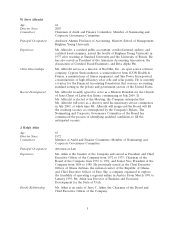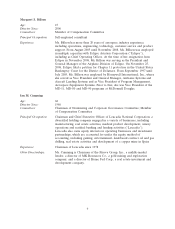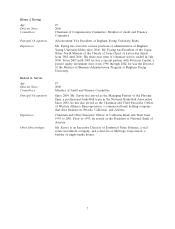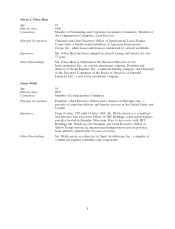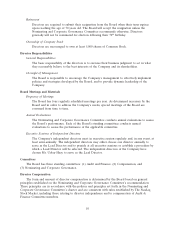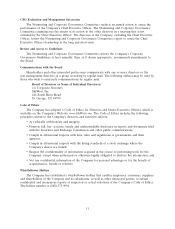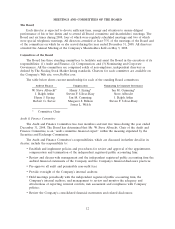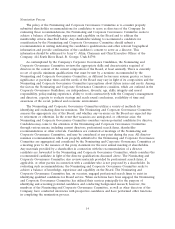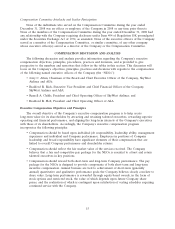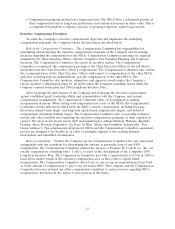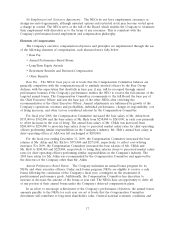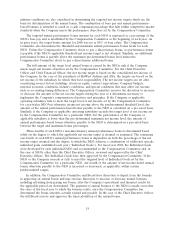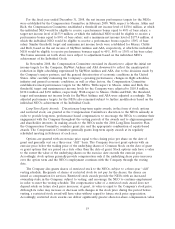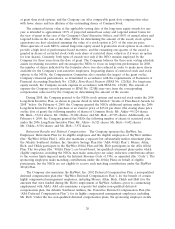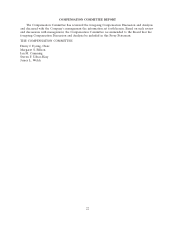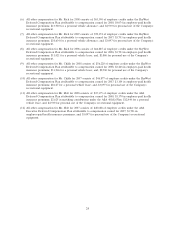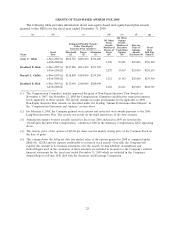SkyWest Airlines 2008 Annual Report Download - page 115
Download and view the complete annual report
Please find page 115 of the 2008 SkyWest Airlines annual report below. You can navigate through the pages in the report by either clicking on the pages listed below, or by using the keyword search tool below to find specific information within the annual report.Compensation Committee Interlocks and Insider Participation
None of the individuals who served on the Compensation Committee during the year ended
December 31, 2008 was an officer or employee of the Company in 2008 or any time prior thereto.
None of the members of the Compensation Committee during the year ended December 31, 2008 had
any relationship with the Company requiring disclosure under Item 404 of Regulation S-K promulgated
under the Securities Exchange Act of 1934, as amended. None of the executive officers of the Company
served as a member of the Compensation Committee, or similar committee, of any other company
whose executive officer(s) served as a director of the Company or the Compensation Committee.
COMPENSATION DISCUSSION AND ANALYSIS
The following discussion and analysis provides information regarding the Company’s executive
compensation objectives, principles, procedures, practices and decisions, and is provided to give
perspective to the numbers and narratives that follow in the tables in this section. This discussion will
focus on the Company’s objectives, principles, practices and decisions with regards to the compensation
of the following named executive officers of the Company (the ‘‘NEOs’’):
• Jerry C. Atkin, Chairman of the Board and Chief Executive Officer of the Company, SkyWest
Airlines and ASA;
• Bradford R. Rich, Executive Vice President and Chief Financial Officer of the Company,
SkyWest Airlines and ASA;
• Russell A. Childs, President and Chief Operating Officer of SkyWest Airlines; and
• Bradford R. Holt, President and Chief Operating Officer of ASA.
Executive Compensation Objectives and Principles
The overall objective of the Company’s executive compensation program is to help create
long-term value for its shareholders by attracting and retaining talented executives, rewarding superior
operating and financial performance, and aligning the long-term interests of the Company’s executives
with those of its shareholders. Accordingly, the Company’s executive compensation program
incorporates the following principles:
• Compensation should be based upon individual job responsibility, leadership ability, management
experience and individual and Company performance. Employees in positions of Company
leadership and broad responsibility have significant elements of their compensation that are
linked to overall Company performance and shareholder returns.
• Compensation should reflect the fair market value of the services received. The Company
believes that a fair and competitive pay package for the NEOs is essential to attract and retain
talented executives in key positions.
• Compensation should reward both short-term and long-term Company performance. The pay
package for the NEOs is designed to provide components of both short-term and long-term
incentive compensation. Annual bonuses are tied to achievement of short-term (generally
annual) quantitative and qualitative performance goals the Company believes closely correlate to
share value. Long-term performance is rewarded through equity-based awards, in the form of
stock options and restricted stock, the value of which depends upon future Company share
prices, and the realization of which is contingent upon satisfaction of vesting schedules requiring
continued service with the Company.
15


